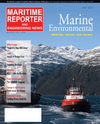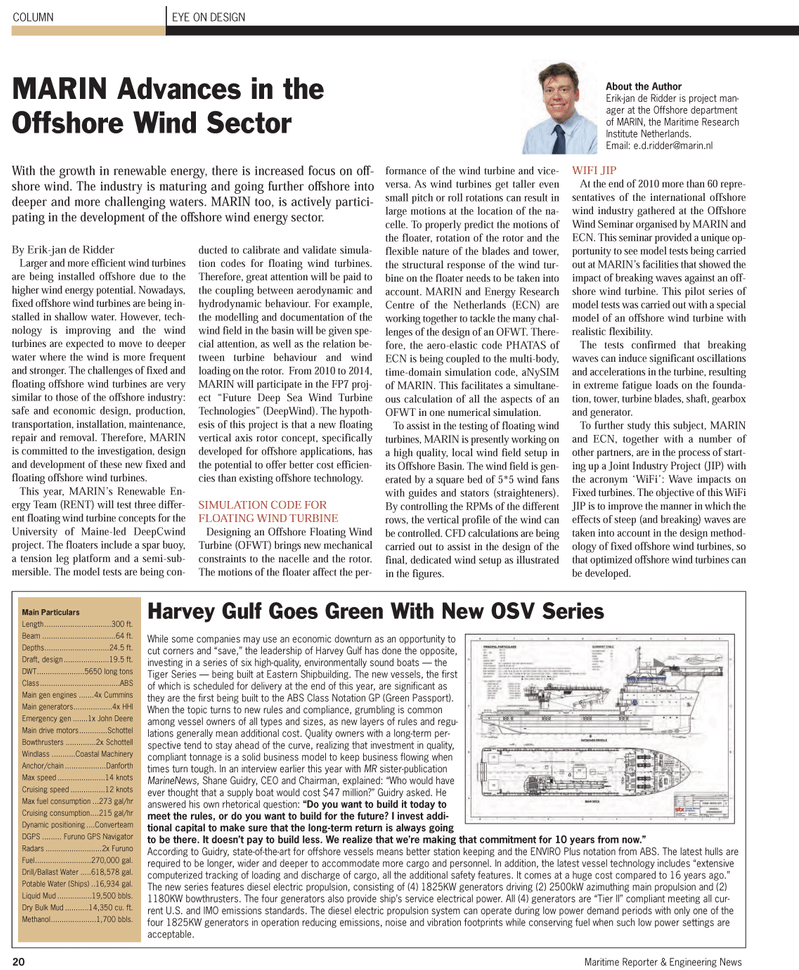
Page 20: of Maritime Reporter Magazine (July 2011)
The Green Ship Edition
Read this page in Pdf, Flash or Html5 edition of July 2011 Maritime Reporter Magazine
Harvey Gulf Goes Green With New OSV Series While some companies may use an economic downturn as an opportunity to cut corners and save,? the leadership of Harvey Gulf has done the opposite,investing in a series of six high-quality, environmentally sound boats ? the Tiger Series ? being built at Eastern Shipbuilding. The new vessels, the firstof which is scheduled for delivery at the end of this year, are significant as they are the first being built to the ABS Class Notation GP (Green Passport). When the topic turns to new rules and compliance, grumbling is commonamong vessel owners of all types and sizes, as new layers of rules and regu- lations generally mean additional cost. Quality owners with a long-term per-spective tend to stay ahead of the curve, realizing that investment in quality, compliant tonnage is a solid business model to keep business flowing whentimes turn tough. In an interview earlier this year with MRsister-publicationMarineNews, Shane Guidry, CEO and Chairman, explained: Who would have ever thought that a supply boat would cost $47 million?? Guidry asked. Heanswered his own rhetorical question: Do you want to build it today tomeet the rules, or do you want to build for the future? I invest addi- tional capital to make sure that the long-term return is always going to be there. It doesnt pay to build less. We realize that were making that commitment for 10 years from now.? According to Guidry, state-of-the-art for offshore vessels means better station keeping and the ENVIRO Plus notation from ABS. The latest hulls are required to be longer, wider and deeper to accommodate more cargo and personnel. In addition, the latest vessel technology incl udes extensivecomputerized tracking of loading and discharge of cargo, all the additional safety features. It comes at a huge cost compared t o 16 years ago.?The new series features diesel electric propulsion, consisting of (4) 1825KW generators driving (2) 2500kW azimuthing main prop ulsion and (2)1180KW bowthrusters. The four generators also provide ships service electrical power. All (4) generators are Tier II? complia nt meeting all cur-rent U.S. and IMO emissions standards. The diesel electric propulsion system can operate during low power demand periods with o nly one of thefour 1825KW generators in operation reducing emissions, noise and vibration footprints while conserving fuel when such low powe r settings are acceptable.20Maritime Reporter & Engineering News EYE ON DESIGNCOLUMNMARIN Advances in theOffshore Wind Sector By Erik-jan de RidderLarger and more efficient wind turbines are being installed offshore due to the higher wind energy potential. Nowadays, fixed offshore wind turbines are being in- stalled in shallow water. However, tech- nology is improving and the wind turbines are expected to move to deeper water where the wind is more frequent and stronger. The challenges of fixed and floating offshore wind turbines are very similar to those of the offshore industry: safe and economic design, production,transportation, installation, maintenance,repair and removal. Therefore, MARIN is committed to the investigation, design and development of these new fixed and floating offshore wind turbines. This year, MARIN?s Renewable En- ergy Team (RENT) will test three differ- ent floating wind turbine concepts for theUniversity of Maine-led DeepCwind project. The floaters include a spar buoy, a tension leg platform and a semi-sub- mersible. The model tests are being con- ducted to calibrate and validate simula- tion codes for floating wind turbines.Therefore, great attention will be paid tothe coupling between aerodynamic andhydrodynamic behaviour. For example, the modelling and documentation of thewind field in the basin will be given spe- cial attention, as well as the relation be-tween turbine behaviour and wind loading on the rotor. From 2010 to 2014, MARIN will participate in the FP7 proj-ect ?Future Deep Sea Wind Turbine Technologies? (DeepWind). The hypoth- esis of this project is that a new floating vertical axis rotor concept, specifically developed for offshore applications, has the potential to offer better cost efficien- cies than existing offshore technology. SIMULATION CODE FOR FLOATING WIND TURBINE Designing an Offshore Floating Wind Turbine (OFWT) brings new mechanical constraints to the nacelle and the rotor. The motions of the floater affect the per- formance of the wind turbine and vice-versa. As wind turbines get taller even small pitch or roll rotations can result inlarge motions at the location of the na- celle. To properly predict the motions of the floater, rotation of the rotor and the flexible nature of the blades and tower, the structural response of the wind tur- bine on the floater needs to be taken into account. MARIN and Energy Research Centre of the Netherlands (ECN) areworking together to tackle the many chal- lenges of the design of an OFWT. There- fore, the aero-elastic code PHATAS of ECN is being coupled to the multi-body, time-domain simulation code, aNySIMof MARIN. This facilitates a simultane- ous calculation of all the aspects of anOFWT in one numerical simulation.To assist in the testing of floating wind turbines, MARIN is presently working on a high quality, local wind field setup in its Offshore Basin. The wind field is gen- erated by a square bed of 5*5 wind fans with guides and stators (straighteners).By controlling the RPMs of the different rows, the vertical profile of the wind can be controlled. CFD calculations are beingcarried out to assist in the design of thefinal, dedicated wind setup as illustrated in the figures. WIFI JIP At the end of 2010 more than 60 repre-sentatives of the international offshore wind industry gathered at the Offshore Wind Seminar organised by MARIN and ECN. This seminar provided a unique op- portunity to see model tests being carriedout at MARIN?s facilities that showed the impact of breaking waves against an off- shore wind turbine. This pilot series of model tests was carried out with a special model of an offshore wind turbine with realistic flexibility. The tests confirmed that breaking waves can induce significant oscillations and accelerations in the turbine, resultingin extreme fatigue loads on the founda- tion, tower, turbine blades, shaft, gearbox and generator. To further study this subject, MARIN and ECN, together with a number ofother partners, are in the process of start-ing up a Joint Industry Project (JIP) withthe acronym ?WiFi?: Wave impacts on Fixed turbines. The objective of this WiFi JIP is to improve the manner in which the effects of steep (and breaking) waves are taken into account in the design method- ology of fixed offshore wind turbines, so that optimized offshore wind turbines can be developed. About the AuthorErik-jan de Ridder is project man- ager at the Offshore department of MARIN, the Maritime Research Institute Netherlands. Email: [email protected] the growth in renewable energy, there is increased focus on off- shore wind. The industry is maturing and going further offshore into deeper and more challenging waters. MARIN too, is actively partici- pating in the development of the offshore wind energy sector. Main Particulars Length...............................300 ft. Beam..................................64 ft. Depths..............................24.5 ft. Draft, design.....................19.5 ft. DWT......................5650 long tons Class.....................................ABS Main gen engines.......4x Cummins Main generators..................4x HHI Emergency gen.......1x John Deere Main drive motors.............Schottel Bowthrusters..............2x Schottell Windlass...........Coastal Machinery Anchor/chain...................Danforth Max speed......................14 knots Cruising speed................12 knots Max fuel consumption...273 gal/hr Cruising consumption....215 gal/hr Dynamic positioning....Converteam DGPS.........Furuno GPS Navigator Radars..........................2x Furuno Fuel..........................270,000 gal. Drill/Ballast Water.....618,578 gal. Potable Water (Ships)..16,934 gal. Liquid Mud................19,500 bbls. Dry Bulk Mud...........14,350 cu. ft. Methanol.....................1,700 bbls.

 19
19

 21
21
